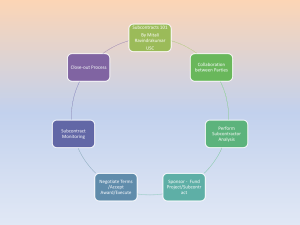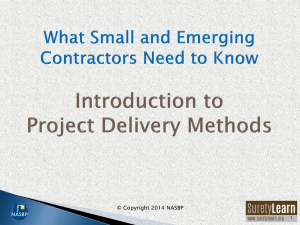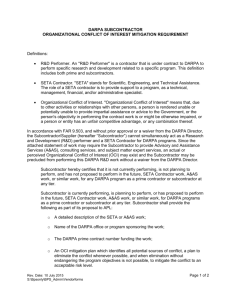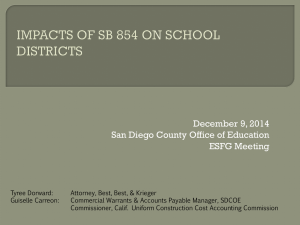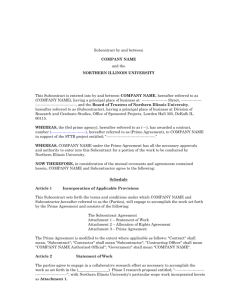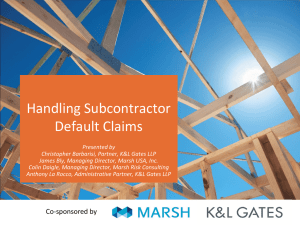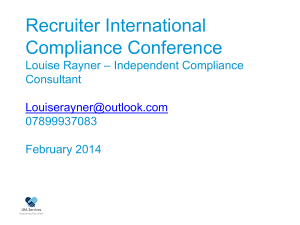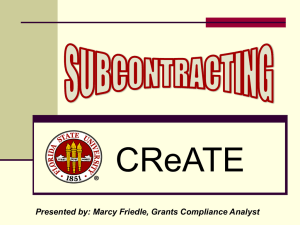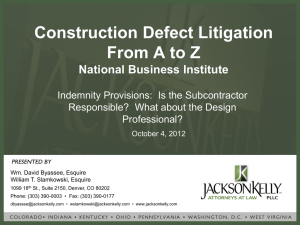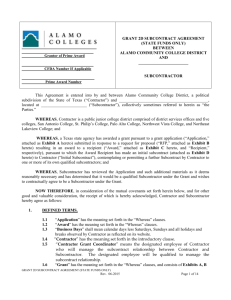Resolution of Contract Disputes - TAAHP
advertisement
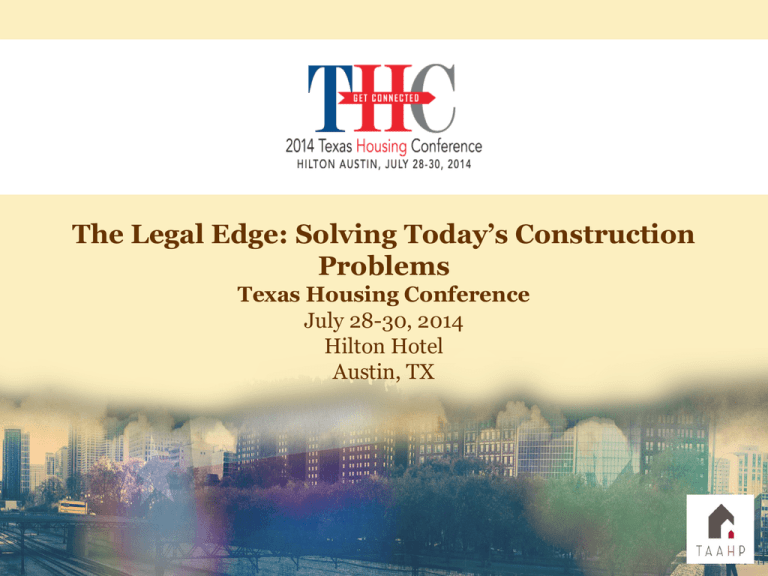
The Legal Edge: Solving Today’s Construction Problems Texas Housing Conference July 28-30, 2014 Hilton Hotel Austin, TX Presenters Moderator Bobby Bowling, Tropicana Homes Panel Members Vijay D'Cruz, Locke Lord Joe Davis, Husch Blackwell Chris Ryman, Coats | Rose Five Key Construction Contract Clauses (among others) Chris E. Ryman Coats, Rose, Yale, Ryman, & Lee, P.C. www.coatsrose.com Presented to: The Texas Affiliation of Affordable Housing Providers 1. Limitation of Liability/ Consequential Damages Waiver “LIMITATION OF LIABILITY AND WAIVER OF CONSEQUENTIAL DAMAGES: IN NO EVENT SHALL THE CONTRACTOR’S LIABILITY TO THE SUBCONTRACTOR EXCEED THE FAIR VALUE OF THE SUBCONTRACTOR’S SERVICES IN CONNECTION WITH THIS SUBCONTRACT … CONTRACTOR AND ITS AFFILIATES SHALL HAVE NO LIABILITY TO SUBCONTRACTOR FOR SPECIAL, INDIRECT OR CONSEQUENTIAL DAMAGES … For purposes of this Subcontract, the term “Consequential Damages” shall mean special, indirect, incidental, or consequential losses or damages, including but not limited to the loss of profits or revenues, the loss or restricted use of property rights, the incurring of financing costs, or any other loss or damage not constituting direct damages deemed by law to be within the contemplation of the parties to this Subcontract at the time it becomes effective.” (abbreviated version) 1. Limitation of Liability/ Consequential Damages Waiver Key points: – Texas court might enforce if conspicuous & specific/ right language used – Sometimes a “save the company” clause: may severely limit liability/ protect against more remote (“consequential”) money damages 2. “No-damages-for-delay” clause “The Contractor shall receive no financial compensation for delay or hindrance of the Work. In no event shall the Owner be liable to the Contactor or any Subcontractor or Supplier, any other person or any surety for or any employee or agent of any of them, for any damages arising out of or associated with any delay or hindrance to the Work, regardless of the source of the delay or hindrance, including events of Force Majeure, AND EVEN IF SUCH DELAY OR HINDRANCE RESULTS FROM, ARISES OUT OF OR IS DUE, IN WHOLE OR IN PART, TO THE NEGLIGENCE, BREACH OF CONTRACT OR OTHER FAULT OF THE OWNER. The Contractor's sole remedy in any such case shall be an extension of time.” 2. “No-damages-for-delay” clause Key points: – GC might only be entitled to time extension; critical in delay cases – Note: enforced by Houston court but currently on appeal to Texas Supreme Court 3. Dispute Resolution “THE SUBCONTRACTOR AGREES TO WAIVE THE RIGHT TO TRIAL BY JURY FOR ANY DISPUTE ARISING OUT OF OR IN ANY WAY RELATED TO THE PROJECT, THE SUBCONTRACT WORK, THE SUBCONTRACT, OR THE CONTRACT DOCUMENTS. The parties shall first, as an express condition precedent, attempt to resolve such disputes by negotiations between their senior executives, … and, if no resolution is then achieved, submission of the dispute to non-binding mediation as soon as possible and within thirty (30) days after the parties mutually agree upon a mediator. … If the parties cannot resolve the dispute by mediation, the Contractor, at its sole discretion, may elect to litigate the dispute in a court of competent jurisdiction or have the matter decided in arbitration ...such appointed arbitrator to be a licensed Texas attorney with at least ten (10) years of construction contract dispute experience… The arbitration award shall be rendered in writing, must include an award of all or substantially all attorney’s fees and costs to the prevailing party…The Subcontractor agrees no such controversy or dispute – including but not limited to mediation or arbitration proceedings – shall interfere with the continuation and progress of the Subcontract Work….” (abbreviated version) 3. Dispute Resolution Key points: – Jury waiver (key for GCs; not as much for owners) – Meeting between officers/ mediation, trying to avoid attorney’s fees – GC’s right to choose arbitration or resolution in court – Arbitrator is qualified & must award attorney’s fees – Sub must continue working despite dispute 4. “Flow down” clause/ consistency “The Contractor’s contract with the Owner, the plans and specifications, the bid documents (all of which are expressly incorporated by reference as if fully set forth herein) and this Subcontract, shall be interpreted to be consistent with one another, and any irreconcilable conflict between the two, or any patent or latent ambiguity, shall be interpreted to require that which is most beneficial to the Contractor.” 4. “Flow down” clause/ consistency Key points: –GC’s obligations to owner “flow down” to sub –Consistency between documents/ favorable to GC 5. Indemnification A. EXCEPT WITH RESPECT TO CLAIMS RELATING TO BODILY INJURY OR DEATH OF AN EMPLOYEE AS DEFINED IN SUBPARAGRAPH 8.3 B. BELOW, SUBCONTRACTOR AGREES TO INDEMNIFY, DEFEND, AND HOLD HARMLESS CONTRACTOR, ALONG WITH ITS PARENTS, SUBSIDIARIES, AFFILIATED COMPANIES AND PARTNERS AND THEIR OFFICERS, DIRECTORS, MANAGERS, AGENTS, SERVANTS AND EMPLOYEES, AND ANY PARTIES REQUIRED TO BE INDEMNIFIED BY CONTRACTOR UNDER THE CONTRACT DOCUMENTS (COLLECTIVELY THE “INDEMNIFIED PARTIES” OR INDIVIDUALLY AN “INDEMNIFIED PARTY”) FROM ALL CLAIMS, SUITS, JUDGMENTS, COSTS AND EXPENSES – INCLUDING ATTORNEY’S FEES AND EXPENSES OF LITIGATION – INVOLVING ECONOMIC LOSS, PERSONAL INJURY, PROPERTY DAMAGE OR WRONGFUL DEATH (“CLAIMS) THAT ACTUALLY OR ALLEGEDLY ARISE OUT OF OR ARE CONNECTED WITH SUBCONTRACTOR’S WORK OR ITS PRESENCE OR THE PRESENCE ANY OF SUBCONTRACTOR’S SUBCONTRACTORS ON THE PROJECT. NOTWITHSTANDING THE FOREGOING, THIS INDEMNITY AND HOLD HARMLESS PROVISION SHALL NOT APPLY TO THE EXTENT THAT IT REQUIRES SUBCONTRACTOR TO INDEMNIFY AN INDEMNIFIED PARTY AGAINST A CLAIM CAUSED BY THE NEGLIGENCE OR FAULT, THE BREACH OR VIOLATION OF A STATUTE, ORDINANCE, GOVERNMENTAL REGULATION, STANDARD, OR RULE, OR THE BREACH OF CONTRACT OF THE INDEMNIFIED PARTY, ITS AGENT OR EMPLOYEE, OR ANY THIRD PARTY UNDER THE CONTROL OR SUPERVISION OF THE INDEMNIFIED PARTY, OTHER THAN SUBCONTRACTOR OR ITS AGENT, EMPLOYEE OR SUBCONTRACTOR OF ANY TIER. 5. Indemnification B. INDEMNITY FOR EMPLOYEE CLAIMS: SUBCONTRACTOR AGREES TO AND SHALL DEFEND, INDEMNIFY AND HOLD HARMLESS (COLLECTIVELY “INDEMNIFY”) CONTRACTOR AND OWNER, AND ANY OTHER PARTIES REQUIRED TO BE INDEMNIFIED BY CONTRACTOR UNDER THE CONTRACT DOCUMENTS AND THEIR REPRESENTATIVES, PARTNERS, MEMBERS, DIRECTORS, OFFICERS, AGENTS, EMPLOYEES, INVITEES OR LICENSEES (COLLECTIVELY THE “INDEMNIFIED PARTIES” OR INDIVIDUALLY AN “INDEMNIFIED PARTY”) FROM AND AGAINST ANY AND ALL CLAIMS, LOSSES, DAMAGES, DEMANDS, INJURIES, JUDGEMENTS, CAUSES OF ACTION, SUITS, AND LIABILITY OF EVERY KIND, INCLUDING BUT NOT LIMITED TO ALL EXPENSES OF LITIGATION, COURT COSTS AND ATTORNEY’S FEES (COLLECTIVELY “CLAIMS”) , FOR BODILY INJURY OR DEATH OF ANY EMPLOYEE OF SUBCONTRACTOR, ITS AGENTS, OR ITS SUBCONTRACTORS OF ANY TIER (COLLECTIVELY “EMPLOYEE” FOR THE PURPOSE OF THIS SECTION), ACTUALLY OR ALLEGEDLY OCCASIONED BY, CONTRIBUTED TO OR ARISING OUT OF, IN WHOLE OR IN PART, THE SUBCONTRACT WORK, THE PERFORMANCE OF THE SUBCONTRACT WORK OR THIS SUBCONTRACT, OR PRESENCE AT THE PROJECT SITE, INCLUDING BUT NOT LIMITED TO CLAIMS DUE TO NEGLIGENCE, GROSS NEGLIGENCE, BREACH OF WARRANTY, BREACH OF CONTRACT, VIOLATION OF ANY STATUTE, RULE OR REGULATION OR OTHER ACT OR OMISSION BY SUBCONTRACTOR, ITS EMPLOYEES, AGENTS OR ANY SUBCONTRACTOR OF SUBCONTRACTOR OF ANY TIER, OR THEIR RESPECTIVE AGENTS OR EMPLOYEES, OR ANY OTHER PARTY FOR WHOSE ACTS SUBCONTRACTOR IS LIABLE. SUBCONTRACTOR’S OBLIGATION TO INDEMNIFY SHALL APPLY EVEN IF SUCH CLAIMS ARE ACTUALLY OR ALLEGEDLY CAUSED IN WHOLE OR IN PART BY THE ACTS, OMISSIONS, OR NEGLIGENCE OF AN INDEMNIFIED PARTY, EVEN IF SUCH NEGLIGENCE OR OTHER ACTS OR OMISSIONS ARE ACTIVE OR PASSIVE, DIRECT OR INDIRECT, SOLE, JOINT OR CONCURRENT. THIS INDEMNITY AGREEMENT IS INTENDED TO INDEMNIFY THE AFOREMENTIONED INDEMNIFIED PARTIES FROM THE CONSEQUENCES OF THEIR OWN NEGLIGENCE, AS PROVIDED ABOVE. 5. Indemnification Key points: - Enforceable only if: 1. Conspicuous 2. Properly worded (claims specified: “express negligence rule”) - Cannot indemnify a party from its own negligence unless it is an employee injury claim 6. Pay-if-paid (“contingent payment”) clauses “Payment by the Owner to the General Contractor shall be an express condition precedent to any obligation by the General Contractor to pay the Subcontractor for the Subcontractor’s Work. The Subcontractor therefore expressly acknowledges and assumes the risk of non-payment from the Owner to the General Contractor.” 6. Pay-if-paid (“contingent payment”) clauses Key points: – SEVERELY restricted by 2007 Legislation (except certain residential & road/ civil/ utility construction, design services) – Enforceable only if properly worded (makes clear payment by upstream party is express condition precedent/ risk is understood); • A “pay-when-paid” clause will not suffice (e.g., “Contractor will pay Subcontractor within 7 days of receiving payment from Owner” ≠ pay-if-paid clause) Chris E Ryman Coats | Rose 3 E. Greenway Plaza Suite 2000 Houston, Texas 77046 (713) 653-7345 cryman@coatsrose.com
